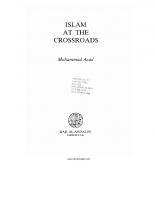Hawaii at the Crossroads of the U.S. and Japan before the Pacific War 9780824862756
Hawai‘i at the Crossroads tells the story of Hawai‘i’s role in the emergence of Japanese cultural and political internat
288 120 1MB
English Pages 256 Year 2008
Table of contents :
Contents
Dedication and Acknowledgments
Introduction
Section I. Cooperation and Conflict in U.S.–Japanese Relations in Hawai‘i Section I Cooperation and Conflict in U.S.–Japanese Relations in Hawai‘i
1. From the Center to the Periphery: Hawai‘i and the Pacific Community
2. “Colossal Illusions”: The Institute of Pacific Relations in U.S.–Japanese Relations, 1919–1938
3. The Japanese Institute of Pacific Relations and the Kellogg-Briand Pact: The Activities and Limitations of Private Diplomacy
4. Hawai‘i, the IPR, and the Japanese Immigration Problem: A Focus on the First and Second IPR Conferences of 1925 and 1927
Section II. The Politics of Americanization from Japanese Immigrant Perspectives
5. Americanizing Hawai‘i’s Japanese: A Transnational Partnership and the Politics of Racial Harmony during the 1920s
6. Social, Cultural, and Spiritual Struggles of the Japanese in Hawai‘i: The Case of Okumura Takie and Imamura Yemyo and Americanization
7. In Search of a New Identity: Shiga Shigetaka’s Recommendations for Japanese in Hawai‘i
8. Buddhism at the Crossroads of the Pacific: Imamura Yemyō and Buddhist Social Ethics
9. In the Strong Wind of the Americanization Movement: The Japanese-Language School Litigation Controversy and Okumura’s Educational Campaign
List of Contributors
Index
Contents
Dedication and Acknowledgments
Introduction
Section I. Cooperation and Conflict in U.S.–Japanese Relations in Hawai‘i Section I Cooperation and Conflict in U.S.–Japanese Relations in Hawai‘i
1. From the Center to the Periphery: Hawai‘i and the Pacific Community
2. “Colossal Illusions”: The Institute of Pacific Relations in U.S.–Japanese Relations, 1919–1938
3. The Japanese Institute of Pacific Relations and the Kellogg-Briand Pact: The Activities and Limitations of Private Diplomacy
4. Hawai‘i, the IPR, and the Japanese Immigration Problem: A Focus on the First and Second IPR Conferences of 1925 and 1927
Section II. The Politics of Americanization from Japanese Immigrant Perspectives
5. Americanizing Hawai‘i’s Japanese: A Transnational Partnership and the Politics of Racial Harmony during the 1920s
6. Social, Cultural, and Spiritual Struggles of the Japanese in Hawai‘i: The Case of Okumura Takie and Imamura Yemyo and Americanization
7. In Search of a New Identity: Shiga Shigetaka’s Recommendations for Japanese in Hawai‘i
8. Buddhism at the Crossroads of the Pacific: Imamura Yemyō and Buddhist Social Ethics
9. In the Strong Wind of the Americanization Movement: The Japanese-Language School Litigation Controversy and Okumura’s Educational Campaign
List of Contributors
Index

- Author / Uploaded
- Jon Thares Davidann (editor)









